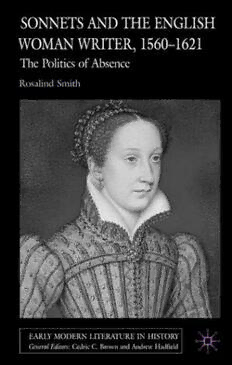
Sonnets and the English Woman Writer, 1560-1621: The Politics of Absence (Early Modern Literature in History) PDF
Preview Sonnets and the English Woman Writer, 1560-1621: The Politics of Absence (Early Modern Literature in History)
Sonnets and the English Woman Writer, 1560–1621 The Politics of Absence Rosalind Smith EarlyModernLiteratureinHistory GeneralEditors:CedricC.Brown,ProfessorofEnglishandDeanoftheFacultyof Arts and Humanities, University of Reading; Andrew Hadfield, Professor of English,UniversityofSussex,Brighton Advisory Board: Donna Hamilton, University of Maryland; Jean Howard, University of Columbia; John Kerrigan, University of Cambridge; Richard McCoy,CUNY;SharonAchinstein,UniversityofOxford Withinthe period1520–1740 this series discussesmanykinds of writing,both within and outside the established canon. The volumes may employ different theoreticalperspectives,buttheyshareanhistoricalawarenessandaninterestin seeingtheirtextsinlivelynegotiationwiththeirownandsuccessivecultures. Titlesinclude: CedricC.BrownandArthurF.Marotti(editors) TEXTSANDCULTURALCHANGEINEARLYMODERNENGLAND MartinButler(editor) RE-PRESENTINGBENJONSON Text,History,Performance JocelynCatty WRITINGRAPE,WRITINGWOMENINEARLYMODERNENGLAND UnbridledSpeech DermotCavanagh LANGUAGEANDPOLITICSINTHESIXTEENTH-CENTURYHISTORYPLAY DanielleClarkeandElizabethClarke(editors) ‘THISDOUBLEVOICE’ GenderedWritinginEarlyModernEngland JamesDaybell(editor) EARLYMODERNWOMEN’SLETTER-WRITING,1450–1700 JeromeDeGroot ROYALISTIDENTITIES JohnDolan POETICOCCASIONFROMMILTONTOWORDSWORTH HenkDragstra,SheilaOttwayandHelenWilcox(editors) BETRAYINGOURSELVES FormsofSelf-RepresentationinEarlyModernEnglishTexts SarahM.Dunnigan EROSANDPOETRYATTHECOURTSOFMARYQUEENOFSCOTSANDJAMESVI AndrewHadfield SHAKESPEARE,SPENSERANDTHEMATTEROFBRITAIN WilliamM.Hamlin TRAGEDYANDSCEPTICISMINSHAKESPEARE’SENGLAND ElizabethHeale AUTOBIOGRAPHYANDAUTHORSHIPINRENAISSANCEVERSE ChroniclesoftheSelf PaulineKiernan STAGINGSHAKESPEAREATTHENEWGLOBE RonaldKnowles(editor) SHAKESPEAREANDCARNIVAL AfterBakhtin ArthurF.Marotti(editor) CATHOLICISMANDANTI-CATHOLICISMINEARLYMODERNENGLISHTEXTS JenniferRichards(editor) EARLYMODERNCIVILDISCOURSES SashaRoberts READINGSHAKESPEARE’SPOEMSINEARLYMODERNENGLAND RosalindSmith SONNETSANDTHEENGLISHWOMANWRITER,1560–1621 ThePoliticsofAbsence MarkThorntonBurnett CONSTRUCTING‘MONSTERS’INSHAKESPEAREANDRAMAANDEARLY MODERNCULTURE MASTERSANDSERVANTSINENGLISHRENAISSANCEDRAMAANDCULTURE AuthorityandObedience TheseriesEarlyModernLiteratureinHistoryispublishedinassociationwith theRenaissanceTextsResearchCentreattheUniversityofReading. EarlyModernLiteratureinHistory SeriesStandingOrderISBN0–333–71472–5 (outsideNorthAmericaonly) You can receive future titles in this series as they are published by placing a standing order. Please contactyour bookseller or, in case of difficulty,write to usattheaddressbelowwithyournameandaddress,thetitleoftheseriesandthe ISBNquotedabove. Customer Services Department, Macmillan Distribution Ltd, Houndmills, Basingstoke,HampshireRG216XS,England Sonnets and the English Woman Writer, 1560–1621 The Politics of Absence Rosalind Smith ªRosalindSmith2005 Allrightsreserved.Noreproduction,copyortransmissionofthis publicationmaybemadewithoutwrittenpermission. Noparagraphofthispublicationmaybereproduced,copiedortransmitted savewithwrittenpermissionorinaccordancewiththeprovisionsofthe Copyright,DesignsandPatentsAct1988,orunderthetermsofanylicence permittinglimitedcopyingissuedbytheCopyrightLicensingAgency, 90TottenhamCourtRoad,LondonW1T4LP. Anypersonwhodoesanyunauthorisedactinrelationtothispublication maybeliabletocriminalprosecutionandcivilclaimsfordamages. Theauthorhasassertedherrighttobeidentified astheauthorofthisworkinaccordancewiththeCopyright, DesignsandPatentsAct1988. Firstpublished2005by PALGRAVEMACMILLAN Houndmills,Basingstoke,HampshireRG216XSand 175FifthAvenue,NewYork,N.Y.10010 Companiesandrepresentativesthroughouttheworld PALGRAVEMACMILLANistheglobalacademicimprintofthePalgrave MacmillandivisionofSt.Martin’sPress,LLCandofPalgraveMacmillanLtd. MacmillanfiisaregisteredtrademarkintheUnitedStates,UnitedKingdom andothercountries.PalgraveisaregisteredtrademarkintheEuropean Unionandothercountries. ISBN-13:978(cid:2)1(cid:2)4039(cid:2)9122(cid:2)5 ISBN-10:1(cid:2)4039(cid:2)9122(cid:2)7 Thisbookisprintedonpapersuitableforrecyclingandmadefromfully managedandsustainedforestsources. AcataloguerecordforthisbookisavailablefromtheBritishLibrary. LibraryofCongressCataloging-in-PublicationData Smith,Rosalind,1968(cid:2) SonnetsandtheEnglishwomanwriter,1560(cid:2)1621:thepoliticsof absence/RosalindSmith. p. cm.(cid:3)(Earlymodernliteratureinhistory) Includesbibliographicalreferences(p.)andindex. ISBN1(cid:2)4039(cid:2)9122(cid:2)7(cloth) 1. Sonnets,English(cid:3)Historyandcriticism. 2. Englishpoetry(cid:3)Women authors(cid:3)Historyandcriticism. 3. Englishpoetry(cid:3)Earlymodern, 1500(cid:2)1700(cid:3)Historyandcriticism. 4. Womenandliterature(cid:3) GreatBritain(cid:3)History(cid:3)16thcentury. 5. Womenandliterature(cid:3) GreatBritain(cid:3)History(cid:3)17thcentury. 6. Poetry(cid:3)Authorship(cid:3)Sex differences(cid:3)History(cid:3)16thcentury. 7. Poetry(cid:3)Authorship(cid:3)Sex differences(cid:3)History(cid:3)17thcentury. I. Title. II. Earlymodern literatureinhistory(PalgraveMacmillan(Firm)) PR509.S7S652005 8210.042099287(cid:3)dc22 2004065756 10 9 8 7 6 5 4 3 2 1 14 13 12 11 10 09 08 07 06 05 PrintedandboundinGreatBritainby AntonyRoweLtd,ChippenhamandEastbourne For Mark, Felix and Isobel This page intentionally left blank Contents Preface viii ListofAbbreviations xii Introduction:Gender,GenreandAttributioninEarly ModernWomen’sSonnetSequencesandCollections 1 1 ‘Inamirrourclere’:AnneLock’sMisereremeiDeusas AdmonitoryProtestantism 13 Attributionandagencyinearlymodernwomen’s writing:ThecaseoftheMeditation 15 Thepoliticsofdedicationandcirculation 26 Out-tropingWyatt 31 2 GeneratingAbsence:TheSonnetsofMaryStuart 39 Thecasketsonnets:Attribution,circulationandsovereign textuality 40 Thepoliticsofabsence:Thecasketsonnetsandthe feminineeroticlyric 46 Thedevotionalsonnets 55 3 ThePoliticsofProsopopoeia:ThePandoraSonnets 61 ThePandorasonnets:TranslationsfromDesportes 65 VentriloquizingElizabethI 72 Thepoliticsofprosopopoeia 79 4 ThePoliticsofWithdrawal:LadyMaryWroth’sPamphilia toAmphilanthusandLindamira’sComplaint 88 ‘Bard...ofLight’:Spenseriannegotiationsin Pamphilia toAmphilanthus 92 ‘Ithusgoearm’dtofield’:Lindamira’sComplaint 109 Conclusion 119 Notes 123 Bibliography 145 Index 165 vii Preface ThisbookexamineswhyEnglishwomenwriterscontributedtoacentral Renaissancelyricform,thesonnetsequence,insuchsmallnumbersand at such odd times in the development of the genre. It might seem perversetoconcentrateuponabsenceratherthanpresenceatthisstage of research inthe fieldof early modern women’sliterary history, espe- cially given the wealth of new writing uncovered in recent feminist scholarship.However,thisbookusestheexampleofthissingle,idiosyn- cratic genre for twopurposes. First, it aims to denaturalize any general assumptionofwomen’sabsenceorexclusionfromparticularmodesof writing in the period. Such instances of absence do not constitute naturalexamplesoffemininelimitationthatcanpassunremarked,but phenomena themselves that might be examined, questioned and ana- lyzed. Second, the study highlights the surprisingly significant conse- quencesarisingfromtheoperationofsuchunexaminedassumptionsof absenceinthefieldofearlymodernwomen’swriting.Takencollectively forthefirsttime,thetextsunderexaminationhereareshowntoradic- ally change the shape of early modern women’s writing in England. Their history shows moments of startling innovation, agency and pos- sibility,aswellasasingleinstanceoftextualcirculationthatmayhave effectively closed down women’s secular lyric activity in print for fifty years.Thisbookarguesthatthisinstance–thecasketsonnetsattributed to Mary Queen of Scots and widely circulated in print as Protestant propaganda from 1571 – involved a scandalous narrative of rape and adulterouslovethatmadethegenresofthesonnetsequenceandfemale complaint unavailable to English women writers in print until Mary Wroth’sunfashionablylate1621 sequencesintheUrania.Thisspecific and local instance of textual circulation worked with a set of cultural prescriptionssurroundingwomen’sconducttoprecludewomen’spartici- pationinthegenreatitsheightinthelateElizabethanperiod. This book therefore challenges the critical commonplace that the gender encodings of the genre of the Petrarchan sonnet themselves limitedorpreventedwomen’suseofthegenre.Itdoessobyhighlight- ingthewaysinwhichwomeninEnglandpractisedthegenrebeforethe publicationofthecasketsonnetsandintheirwake,andbycomparing the English tradition to a surprisingly prolific Continental tradition of women’ssonnetwritingintheItalianandFrenchRenaissances.Inline viii Preface ix withmuchrecentworkonwomen’swritinginthefieldofearlymodern studies, this book also challenges the idea that when women writers usedthegenre,theydidsoinwaysessentiallyorpredictablydifferentto the practice of their male counterparts. Gender does make differences heretowomen’spracticewithinthegenre,butthesearenotdifferences that always manifest themselves in the same ways – especially not through a consistent interest in the ‘private’ emotional or domestic concernsthat have beenargued inthepast.The study’sconcentration ontheparticularconditionsofproduction,circulationandreceptionof these sequences seeks to illuminate a more complex understanding of thewayinwhichgenderandgenreintersectintheperiod.Indifferent ways,thesetextsalloperatedaspoliticalinterventionsunderwrittenby Protestantism;butwhatProtestantismmeantineachofthesecontexts, and the agency that it afforded or denied women authors and con- structions of women’s writing, differs radically in each literary history tracedhere. An early reader of this material commented that she could not see howanyonecouldmakeanargumentfromsuchastrangecollectionof poetry.Inthisrespect,thisbookistheproductofitscriticalgeneration, whichfavourstheobscureoverthecanonical:neglectedpoeticcoteries; once overlooked genres such as the newsbook, pamphlet, or sermon; andmarginalpractitionerssuchasthepornographersoftheElizabethan lyric. But there is a sense that the material examined here is at the far reaches of this literary marginality. This is in part because the texts appear in anomalous circumstances, where an early history of secular lyric agency and innovation in the genres of sonnet and complaint is almost immediately foreclosed. Theseearlyconventions of sonnet and complaint,neverrepeatedinthehistoryoftheElizabethanlyric,remain odd and unfamiliar. But the marginality of many of the texts under consideration here also derives from their status as works of uncertain attribution.Consideredneitherasasecurepartofthecanonofwomen’s writing nor as male-authored texts, their unresolved problems of authorship means that they have remained at the edges of literary history. This book uses the uncertainty surrounding these texts to expose a set of methodological problems and omissions in the field of earlymodernwomen’swriting. Ononehand,thisstudyarguesthatquestionsofattributionmatter.It is not enough to make strained and poorly supported ascriptions of authorshiptowomenwritersinthehopeoffalselybolsteringthenum- beranddiversityofwomen’stextsintheperiod.Contestedattributions need detailed and scrupulous attention, and the possibility of male
